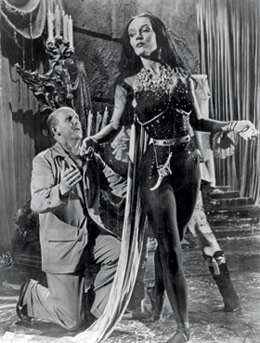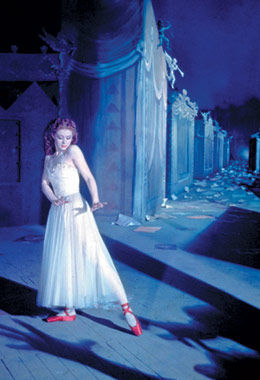BY GARY GIDDINS
 Michael Powell on The Tales of Hoffman
Michael Powell on The Tales of Hoffman
(Credit: Everett Collection)
The Red Shoes remains, after 62 years, a peerless caprice of cinematic trickery, Technicolor opulence, theatrical histrionics, and a triumphant mosaic of ballet, music, and turbulent drama. Even the credits, each card a different painting, the music swelling with operatic grandeur, exhibits the comprehensive command and artistic precision that is the hallmark not only of the film but also of its director, Michael Powell. By 1948, the production company Powell created with the writer-producer Emeric Pressburger, called the Archers and represented famously by the logo of an arrow smacking into a bull's-eye, had enjoyed several hits. Yet moneymen in Britain figured The Red Shoes for an overweening fiasco. Its enormous success on both sides of the Atlantic was one of the marvels of the era.
But Powell and Pressburger were a rare team for any era. They shared a love of high culture and a belief in cinema as religion—a reality apart from reality. They also complemented each other temperamentally—Powell the buccaneer, vain and stubborn; Pressburger the thinker, reserved and reasonable. Together, they made 14 films over 17 years that defined a new, often phantasmagoric course for British cinema, building—as Powell noted—on the freely imagined visions of such fantasists as Georges Méliès, Walt Disney, and the Victor Fleming who made The Wizard of Oz. Yet today, Powell is the artist we most care about, and the main reason is simply that film is a director's art. And people who paid attention to such things knew that Powell was the director, and Pressburger the writer-producer. As exceptionally fine as the scenarios are, it isn't dialogue that haunts our dreams and brings us back to the films again and again; it's the visual tapestry. Everyone involved in turning the written blueprint into film was put through his or her paces by the imperious Powell.
That, in fact, is a central theme of The Red Shoes. We watch the title ballet come to life as the right composer, dancer, choreographer, set designer, conductor, and others are recruited and worked day and night. Yet in the end, one of them turns to the supreme puppet master, Boris Lermontov (Anton Walbrook), director of the Lermontov Ballet, and marvels at his ability to produce a masterpiece out of…nothing. In the citadel of his own genius, Lermontov is willing to dismiss any collaborator who does not accede to his will, including the company's lead ballerina, Victoria Page (Moira Shearer), should she allow her private life to rival her loyalty to his church. Yet Powell also identified with his star dancer. In The Red Shoes, The Tales of Hoffmann (1951) and Black Narcissus (1947), divided loyalties are fatal. In the initially reviled Peeping Tom (1960), a filmmaker damaged by the obsessions of his father, played by Powell, murders his "stars," including a beautiful jazz dancing stand-in played by Shearer, cramming her into a trunk and then regretting that the lighting failed him in the moment of her death throes.
 The Red Shoes (Credit: Criterion)
The Red Shoes (Credit: Criterion)
The Red Shoes, a blockbuster in its day, had sustained its sheen as a classic, but its breathtaking veneer as painted by the great cinematographer Jack Cardiff succumbed to time. So the recent restoration by the Film Foundation, now in its 20th year of preserving such treasures, and offered by Criterion in standard and Blu-ray editions, is a major DVD event. One reason the color films of Powell and Pressburger look so distinct is that Powell stood up to Natalie Kalmus, who for more than 15 years managed to attach herself as the consultant to every Technicolor film, even though she had long been divorced from the man who invented the process. Her arrogance in demanding saturated primary colors met its match in Powell, who showed that finessed color could amplify the emotional state of characters no less than music, framing, or performances. The restoration required correcting each of three black-and-white film strips before they could be dyed and combined, and the result is lustrous. Modern film stock offers the filmmaker documentary flexibility, but Powell sought and achieved the opposite: artificiality so artfully controlled that the viewer can't be certain if a palpably blue sky is genuine or a matte effect.
The most startling example of Powell's control is Black Narcissus (another new Criterion DVD) for which the director surprised Pressburger, as well as Cardiff, production designer Alfred Junge, and costumer Hein Heckroth (frequent associates of the Archers) in announcing that they would not be traveling to India for location shots. The central location, a Himalayan convent, formerly a seraglio, would be created at Pinewood Studios with the use of matte paintings (some on glass), plaster miniatures, wind machines, and severe camera angles to indicate dizzying heights. Powell's mastery somehow conveys claustrophobic insularity amid the infinite spaces of mountain wilderness. An erotic film about nuns adrift in a culture no less religiously superstitious than their own, it links madness to unrequited longing, producing one of the most startling horror effects in cinema. The prioress (Deborah Kerr) enters the cell of Kathleen Byron's Sister Ruth and gasps at what she sees. We gasp as well. No one but Powell could astonish us with the sight of Byron, stunning in a burgundy dress, standing against a deep blue sky and the black hatch work of her windows, her red hair coiffed like an aureole, eyes glossy, scarlet lips folding upward into a perfect V.
Nothing in Black Narcissus is real except the emotional turmoil. When we first see the domineering mediator assigned to aid the nuns, Mr. Dean (David Farrar), he looks vaguely absurd, riding a preposterously small white pony, wearing an effeminate Robin Hood sort of hat, and only gradually reveals himself as a smug but indifferent rooster in a hen house. Jean Simmons, as a teenage Indian seductress and thief, goes into a sexy dance so suddenly you cannot help but laugh in pleasurable surprise. Sister Ruth, crazily reveling in ill-fortune from the outset, is finally transformed into a demon—stringy hair, face kabuki white, darting through the shadows, intent on murder, and plummeting, as Vicky Page would do a year later in The Red Shoes, from a great height. This sequence, about six minutes long, reflects one of Powell's most ingenious inspirations: it was edited by Reginald Mills to the recorded score by Brian Easdale, as though it were a silent horror film. The winds howl but the morning light has a roseate glow and even the water looks bloody.
Born near Canterbury in 1905, Powell was only 55 when the failure of Peeping Tom cashiered his career in England. Taking into account a long apprenticeship, nearly 15 years during which he turned out two dozen "quota quickies" to complete the bottom half of bills dominated by Hollywood, his great period was largely confined to the 1940s. He made several good propaganda thrillers, including The Spy in Black (1939, his first film with Pressburger, unavailable on DVD), Contraband (1940, available from Kino) and 49th Parallel (1941, Criterion), before the Archers' 1943 coup The Life and Death of Colonel Blimp. Here the eternal feminine (Deborah Kerr in three roles) is caught in the battle for dominion between industrious youth and complacent age with a war at stake. Churchill disapproved, but audiences were dazzled by its defiant originality. After several other deft triumphs, including I Know Where I'm Going! (1945, Criterion) and A Matter of Life and Death (1946, Columbia), the Archers petered out in the mid-1950s with two relatively conventional, even Blimpish war films.
 Peeping Tom (Credit: Photofest)
Peeping Tom (Credit: Photofest)
By contrast, Peeping Tom (the Criterion DVD is presently out of print) bristled with cold wit and electrifying immediacy. Released a few months before Psycho, it had no blood, but it violated three sanctions of the modern horror film, long a despised genre among British film critics. It sympathetically portrayed the killer (an infallibly measured performance by Carl Boehm), took place in modern London rather than in the Gothic 19th century patented by Hammer Films, and implicated the audience as voyeurs. Truly horrified at what the kingdom and particularly Powell had come to, critics failed to notice the broad undercurrent of rueful humor. The murderer's weapon is the erect leg of a camera tripod, which must be circumcised of a protective cap to reveal a sword. After a psychiatrist explains scoptophilia, the sexual pleasure derived from looking at images, a detective asks if he noticed anyone suspicious on a film set. The psychiatrist points to an "aggressive" individual (not the killer) who "seems to have something on his mind." No wonder, the detective tells him, "He's the director."
The eventual recognition of Peeping Tom as a classic underscored Powell's consistent yet often overlooked use of cinematic horror images. The most romantic episode in The Red Shoes, as Vicky and the composer Julian Craster (Marius Goring) make love in a coach driven by a sleeping coachman, cuts to the insanely jealous Lermontov watching Swan Lake, which had provided the musical theme for Universal's 1930s horror films. In The Tales of Hoffmann (out of print and badly in need of a restoration), the images include Shearer's dislocated head, demonic masks, and the choreographer Robert Helpmann as a deranged toymaker made to look like the estate agent in F.W. Murnau's Nosferatu. The Small Back Room, a brilliantly incisive black-and-white film from 1949 (Criterion), is at once a love story, a look at the conflict between wartime soldiers and civilian masters, and a thriller about bomb-defusing every bit as tense as Kathryn Bigelow's The Hurt Locker, yet it stops dead for an expressionistic fantasy of alcoholic terror.
With his career shattered and his work forgotten or downgraded in memory, Powell went to Australia where, thanks to the participation of James Mason as actor and producer, he made Age of Consent, in 1969 (part of Columbia's The Films of Michael Powell, along with the enchanting A Matter of Life and Death, 1946, which manages to combine the eschatological dream of a comatose hospital patient with a love story and a debate about the relative values of British and American cultural mores). A highly personal film that at first blush may seem light and even frivolous, Age of Consent offers a positive spin to Powell's familiar themes. This time the artist, a painter who secludes himself on an Australian reef, discovers a beautiful, unlettered, teenage thief (Helen Mirren's stunning film debut), who poses as his model and becomes his muse, reviving his energies as an artist and holding out the fulfillment of a private life as well. They are surrounded by grotesques, including an evil stepmother who, like her predecessor in Snow White, falls from a cliff. But the blinding Australian sun purifies artist and subject. This was the first of two vindications for Powell. The second, a gift of longevity (he died in 1990), allowed him to live to see the world come around to his own assessment of his achievement, which was one of the most impressive in the history of the British or perhaps any other film industry.